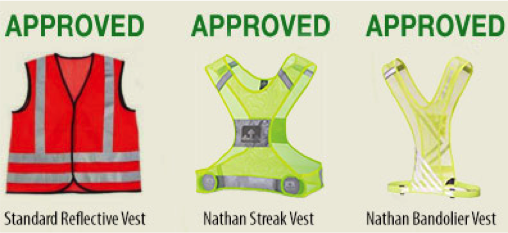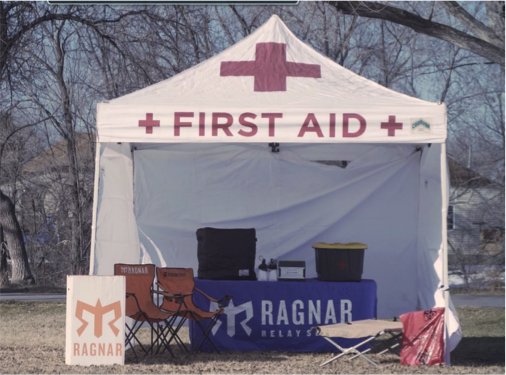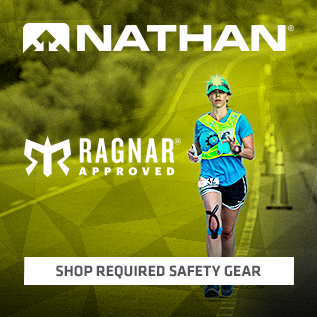To help ensure your safety, please review the course rules as stated in the Race Bible.
Safety is our number one priority. There are many potential hazards in an open road race of this type including, but not limited to: automobile traffic, road and trail conditions, and weather. We ask that all teams please take appropriate precautions to ensure a fun and safe event. Please help us keep the relay safe by focusing on being safe runners, safe support crews, and by helping us keep the relay as a whole safe.
SAFETY RULES
Rules and safety guidelines are listed in the Race Bible and also will be available in the Ragnar app.
SAFETY BRIEFING
There will be a mandatory safety briefing at the race Start Line for Van One and at Exchange Six for Van Two. Each team is required to have all team members, who are present, attend the safety briefing The safety training will last approximately 10-15 minutes. Please arrive at least one hour early to the Start Line and Exchange Six to give your team adequate time to go through the safety briefing and get checked-in.
NIGHT TIME GEAR
Each van must check in on race day one full hour prior to their start time with six reflective vests, two headlamps or running flashlights and two blinking LED taillights (we recommend you bring extra batteries).
You are only visible to drivers closer than 200-feet away in dark conditions. Most reflective vests make it so runners become visible to drivers up to 1200+ feet. Adding headlamps and flashing LED taillights provides increased visibility and safety.
CROSSING FLAGS
Any participant (not the runner) who is outside of their team van and crossing a road, must do so with the aid of an orange crossing flag. Ragnar provides two orange crossing flags to each van before the race which need to be returned at the finish line.
NO VAN SUPPORT LEGSS
Certain legs of the race are designated as No Van Support. This means that participants (not the runners) are not allowed outside of the van to support their runners. Ragnar will provide a water station(s) on longer No Van Support legs.
PARTIAL NO VAN SUPPORT LEGS
Certain legs of the race are designated as Partial No Van Support legs. This means that participants (not the runners) are not allowed outside of the van to support their runners on certain designated sections of the leg. These non-support areas will be identified on the leg maps and leg descriptions. Ragnar will provide a water station(s) on longer No Van Support sections.
SAFETY OFFICER
Each Ragnar Relay van is required to have a safety officer/navigator that is awake at all times. The safety officer is responsible for making sure the driver stays awake while driving and that the team always has safety on the brain.
MEDIC STATIONS
Ragnar provides a medic station at each of the five major exchanges (Ex 6, 12, 18, 24, 30) and the Finish Line. The medics at these stations are equipped to deal with first aid issues and minor medical issues. In the case of a medical emergency call 911 immediately and then let us know by sending a TEXT to 661- RAGNAR1. NOTE that we do not have enough band-aids, moleskin and ice to give to every runner. Make sure your team vans are stocked with first aid supplies and ice.
COMMUNICATION
Ragnar is capable of constant communication with teams, volunteers and staff during the race. If there is an issue along the course that needs to be addressed please let us know by TEXTING 661-RAGNAR1. If there is a medical emergency call 911 immediately. Each van provides a race day cell phone number that Ragnar can text during the race with emergency information, weather updates and race day changes.
RUNNING IN THE HEAT
Running in hot, humid, and sunny conditions can be taxing on the body. Know your limits. Keep an eye on your active runners and the runners from other teams. Know the signs of dehydration, heat exhaustion and heat stroke. Pre-hydrate before your runs, hydrate during your runs, and re-hydrate after your runs. Electrolyte replacement is just as important as hydration. We recommend mixing in electrolytes with your water to optimize your electrolyte levels and keep you hydrated. Proper hydration is obtained when the runner has clear (light lemonade colored) and copious urine. Keeping your core body temperature as low as possible is also a vital component of running in the heat. Dumping cold water on your head and neck and slowing your pace are two great ways to help keep your body’s temperature under control. Also, be sure to consult your doctor if you have a pre-existing condition that may be exacerbated by running in hot conditions.
OTHER SAFETY TIPS FOR RUNNERS
We recommend that runners run against traffic as a general rule of thumb. Running against traffic ensures better visibility for automobiles, cyclists and runners. Signs on the course will indicate when to run with traffic. Whether they are training for a Ragnar or any other race, runners should wear a reflective vest, headlamp and blinking LED taillight if they are running at night.
The use of personal music devices with headphones while running is strongly discouraged. Urban running requires that all runners be alert and aware of their surroundings at all times. Wearing personal music devices causes distractions and the inability to hear what is going on around the runner. If you still choose to use them, you do so at your own risk and must meet the following requirements:
- Be aware of the sounds around you.
- Be able to hear instructions from course officials when speaking at a reasonable tone (not yelling).
- Be able to hear “on your left.” Listen for other runners trying to pass you.
Safe use tactics
- When running you should be able to hear you own footsteps, if you can’t your volume is too high.
- Run with one earphone out and one in, again you should be able to hear your own footsteps.







